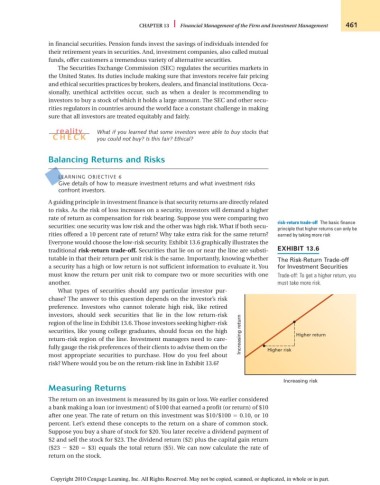Page 487 - Introduction to Business
P. 487
CHAPTER 13 Financial Management of the Firm and Investment Management 461
in financial securities. Pension funds invest the savings of individuals intended for
their retirement years in securities. And, investment companies, also called mutual
funds, offer customers a tremendous variety of alternative securities.
The Securities Exchange Commission (SEC) regulates the securities markets in
the United States. Its duties include making sure that investors receive fair pricing
and ethical securities practices by brokers, dealers, and financial institutions. Occa-
sionally, unethical activities occur, such as when a dealer is recommending to
investors to buy a stock of which it holds a large amount. The SEC and other secu-
rities regulators in countries around the world face a constant challenge in making
sure that all investors are treated equitably and fairly.
reality What if you learned that some investors were able to buy stocks that
CH ECK you could not buy? Is this fair? Ethical?
Balancing Returns and Risks
LEARNING OBJECTIVE 6
Give details of how to measure investment returns and what investment risks
confront investors.
A guiding principle in investment finance is that security returns are directly related
to risks. As the risk of loss increases on a security, investors will demand a higher
rate of return as compensation for risk bearing. Suppose you were comparing two
risk-return trade-off The basic finance
securities: one security was low risk and the other was high risk. What if both secu- principle that higher returns can only be
rities offered a 10 percent rate of return? Why take extra risk for the same return? earned by taking more risk
Everyone would choose the low-risk security. Exhibit 13.6 graphically illustrates the
traditional risk-return trade-off. Securities that lie on or near the line are substi- EXHIBIT 13.6
tutable in that their return per unit risk is the same. Importantly, knowing whether The Risk-Return Trade-off
a security has a high or low return is not sufficient information to evaluate it. You for Investment Securities
must know the return per unit risk to compare two or more securities with one Trade-off: To get a higher return, you
another. must take more risk.
What types of securities should any particular investor pur-
chase? The answer to this question depends on the investor’s risk
preference. Investors who cannot tolerate high risk, like retired
investors, should seek securities that lie in the low return-risk
region of the line in Exhibit 13.6. Those investors seeking higher-risk
securities, like young college graduates, should focus on the high Increasing return Higher return
return-risk region of the line. Investment managers need to care-
fully gauge the risk preferences of their clients to advise them on the Higher risk
most appropriate securities to purchase. How do you feel about
risk? Where would you be on the return-risk line in Exhibit 13.6?
Increasing risk
Measuring Returns
The return on an investment is measured by its gain or loss. We earlier considered
a bank making a loan (or investment) of $100 that earned a profit (or return) of $10
after one year. The rate of return on this investment was $10/$100 0.10, or 10
percent. Let’s extend these concepts to the return on a share of common stock.
Suppose you buy a share of stock for $20. You later receive a dividend payment of
$2 and sell the stock for $23. The dividend return ($2) plus the capital gain return
($23 $20 $3) equals the total return ($5). We can now calculate the rate of
return on the stock.
Copyright 2010 Cengage Learning, Inc. All Rights Reserved. May not be copied, scanned, or duplicated, in whole or in part.

